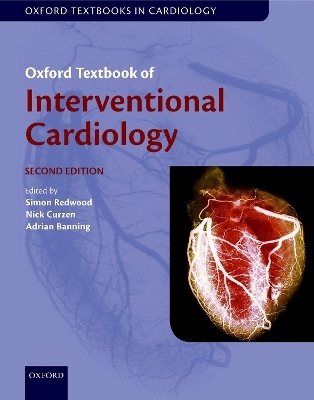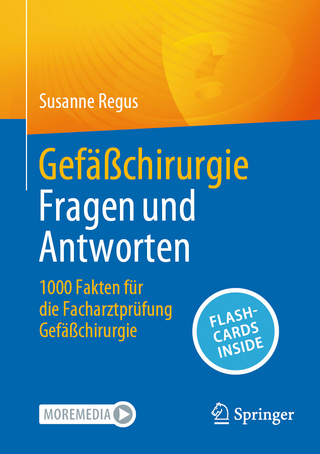
Oxford Textbook of Interventional Cardiology
Oxford University Press (Verlag)
978-0-19-875415-2 (ISBN)
Cardiac catheterization and coronary angiography remain key tools in the management of patients with coronary heart disease. Although this is the most frequently used method of coronary revascularization, general training in cardiology rarely offers more than the opportunity to assist a more senior operator to perform angioplasty procedures.
This textbook, covering key procedures and fully revised and updated to include the latest trials, technology, and new techniques, is essential reading. The Oxford Textbook of Interventional Cardiology, 2nd edition spans the whole spectrum of interventional cardiology procedures, including a novel section on the future of interventional cardiology, and multiple new chapters covering special devices in percutaneous coronary intervention. Written by an expert team of international authors, this book offers guidance on all aspects of interventional cardiology according the European curriculum, and covers the evidence-based guidelines for a comprehensive view of the field.
Simon Redwood trained in cardiology at The Royal London Hospital, The Royal Free Hospital and St. George's Hospital, London. Interventional training was obtained at The Washington Cardiology Center, Washington, DC and Guy's and St. Thomas' Hospitals. He obtained Fellowship of the American College of Cardiology in 2001 and became a Fellow of the Royal College of Physicians in 2003 and Fellow of the Society of Angiography and Interventions in 2004. Dr Redwood is Reader/ Consultant Interventional Cardiologist and Director of the Cardiac Catheter labs at St. Thomas', one of the highest volume catheter lab suites in the UK. He is also a Council Member and Treasurer of the British Cardiovascular Intervention Society. He is trained in all aspects of adult interventional cardiology including intravascular ultrasound, physiological lesion assessment using pressure-sensor tipped wires, stent implantation, rotational atherectomy, and laser angioplasty including the laserwire for chronic total occlusions.
Nick Curzen is a consultant cardiologist with a special interest in coronary intervention at Southampton University Hospitals NHS Trust and Honorary Senior Lecturer at Southampton University Medical School. He qualified from Southampton with Honours in 1987 and obtained MRCP in 1990. In 1996 he was awarded his PhD from Imperial College, London, for a thesis involving vascular pharmacology and molecular biology. His clinical training was at Southampton University, Royal Bournemouth, Royal Brompton, London Chest and St Bartholomews hospitals. He became a consultant interventional cardiologist at Manchester Royal Infirmary in 1999 and moved to Wessex Cardiothoracic Centre, Southampton in January 2004.
Adrian Banning is consultant cardiologist at the John Radcliffe University Hospital, Oxford, and currently holds the post of President of the British Cardiovascular Intervention Society (BCIS). He was the Clinical Lead for cardiac medicine, and subsequently the Divisional Director for Cardiology, Cardiothoracic, and Vascular Surgery for the John Radcliffe, and has been the leading investigator for multiple practice-changing trials, including Syntax, Excel, and Horizons. He qualified from St George's Hospital, London in 1987, and obtained Fellowship of the European Society of Cardiology in 2001, followed by Fellowship of the Royal College of Physicians in 2003. He was Assistant Editor to the journal Heart for six years, and has published over 190 peer reviewed papers.
Background and basics
1: Robert Henderson, Richard Varcoe: The epidemiology and pathophysiology of coronary artery disease
2: Toby Rogers, Kenneth Kent, and Augusto D. Pichard: The history of interventional cardiology
3: Peter F. Ludman: Risk assessment and analysis of outcomes
4: David H. Roberts: Vascular access: femoral versus radial
5: Gurbir Bhatia, James Nolan: Radiation and percutaneous coronary intervention
6: Rod Stables: The 'golden rules' of percutaneous coronary intervention
7: Kevin O'Gallagher, Jonathan Byrne, and Philip MacCarthy: Routine management after percutaneous coronary intervention
8: Ayman Al-Saleh and Sanjit Jolly: Trial design and interpretation: statistics in PCI
Percutaneous coronary intervention-related imaging
9: David Adlam, Annette Maznyczka, and Bernard Prendergast: Angiography: indications and limitations
10: Olivier Muller, Stephane Fournier, Bernard De Bruyne: Coronary physiology in clinical practice
11: Hiromasa Otake, Yasuhiro Honda, and Peter J. Fitzgerald: The role of intravascular ultrasound in percutaneous coronary intervention
12: Ravinay Bhindi and Keith M. Channon: Optical Coherence Tomography in Percutaneous Coronary Intervention
13: A. Coenen, L.E. Swart, R.P.J. Budde, and K. Nieman: Coronary computed tomography for the interventionalist
14: Theodoros D. Karamitsos and Stefan Neubauer: Cardiovascular magnetic resonance
Percutaneous coronary intervention by clinical syndrome
15: Vasim Farooq and Patrick W. Serruys: Stable coronary artery disease: medical therapy versus percutaneous coronary intervention versus surgery
16: Bashir Alaour, Michael Mahmoudi and Nick Curzen: Percutaneous coronary intervention in non-ST elevation acute coronary syndrome
17: Zulfiquar Adam and Mark A. de Belder: Primary percutaneous coronary intervention for ST elevation myocardial infarction
18: Divaka Perera and Natalia Briceno: Percutaneous coronary intervention in patients with impaired left ventricular function
Percutaneous coronary intervention by lesion and patient subsets
19: Yves Louvard, Philippe Garot, Thomas Hovasse, Bernard Chevalier, and Thierry Lefevre: Coronary bifurcation stenting: state of the art
20: Michael Mahmoudi, Nick Curzen, Christine Hughes, Bruno Farah, and Jean Fajadet: Percutaneous coronary intervention for unprotected and protected left main stem disease
21: Colm G. Hanratty, James C. Spratt, Simon J. Walsh: Chronic total occlusions
22: George Kassimis and Adrian P. Banning: Revascularisation in patients with diabetes mellitus
23: Marko Noc and Peter Radsel: Out of Hospital Arrest: Role of PCI
Adjunctive drug therapies in percutaneous coronary intervention
24: Vikram Khanna, Tony Gershlick and Nick Curzen: Current status of oralantiplatelet therapies
25: Tim Lockie: Current status of GP IIb/IIIa inhibitors
26: Stefanie Schupke, Steffen Massberg, and Adnan Kastrati: The role of bivalirudin in percutaneous coronary intervention
27: Simon J. Corbett and Nick Curzen: Optimal medical therapy in percutaneous coronary intervention patients: statins and ACE inhibitors as disease-modifying agents
28: Mikhail S. Dzeshka, Richard A. Brown, and Gregory Y.H. Lip: New Oral Anti-Coagulants (NOACs) and other Adjunctive Therapies
Complications of percutaneous coronary intervention
29: Peter A. McCullough: Contrast-induced acute kidney injury
30: Jaya Chandrasekhar, Adriano Caixeta, Philippe Genereux, George Dangas, and Roxana Mehran: In-stent restenosis in the drug-eluting stent era
31: Nikesh Malik, Amerjeet Banning, and Tony Gershlick: Stent thrombosis
32: Adam de Belder: Stent loss and retrieval
33: Mark Gunning and Chee Wah Khoo: Coronary artery perforation
Special devices in percutaneous coronary intervention
34: Adam de Belder, Martyn Thomas, and Emanuele Barbato: Rotational atherectomy
35: Peter O'Kane and Simon Redwood: Laser
36: Giovanni Luigi De Maria and Adrian P. Banning: Saphenous Vein Graft PCI, Distal Protection and no-reflow
37: Adam J. Brown and Nick E. J. West: Bioresorbable Vascular Scaffolds
38: Corrado Tamburino, Claudia Ina Tamburino and Sebastiano Imme: Access Sites and the TAVI Procedure
39: Mohamed Abdel-Wahab and John Jose: Selection of TAVI Prostheses
40: Muhammed Zeeshan Khawaja and Simon Redwood: Co-existent Coronary Artery Disease in Patients Undergoing TAVI: When and When Not to Treat
41: Michael Bellamy and Christopher Baker: Transcatheter Mitral Valve Repair
42: Ricardo Boix Garibo, Mohsin Uzzaman, Michael Ghosh-Dastidar, and Vinayak Bapat: Transcatheter Mitral Valve Replacement
Other Non-coronary percutaneous interventions
43: Patrick A. Calvert, Bushra S. Rana, Roland Hilling-Smith, and David Hildick-Smith: Percutaneous device closure of atrial septal defect and patent foramen ovale
44: Alec Vahanian, Dominique Himbert, Eric Brochet, Gregory Ducrocq, and Bernard Iung: Mitral balloon valvuloplasty
45: Charles Knight, Saidi Mohiddin, and Constantinos O'Mahony: Alcohol septal ablation for obstructive hypertrophic cardiomyopathy
46: Iqbal Malik and Mohamed Hamady: Carotid artery stenting
47: Tim Betts: Left Atrial Appendage Occlusion
The Future
48: Kenneth Chan, Manish Saxena, and Melvin D. Lobo: Novel Therapies for Hypertension
49: Giora Weisz: Robotic PCI
50: Fizzah Choudry and Anthony Mathur: Stem Cell Therapy and Delivery
| Erscheinungsdatum | 27.09.2018 |
|---|---|
| Reihe/Serie | Oxford Textbooks in Cardiology |
| Verlagsort | Oxford |
| Sprache | englisch |
| Maße | 225 x 280 mm |
| Gewicht | 2158 g |
| Einbandart | gebunden |
| Themenwelt | Medizinische Fachgebiete ► Chirurgie ► Herz- / Thorax- / Gefäßchirurgie |
| Medizinische Fachgebiete ► Innere Medizin ► Kardiologie / Angiologie | |
| ISBN-10 | 0-19-875415-9 / 0198754159 |
| ISBN-13 | 978-0-19-875415-2 / 9780198754152 |
| Zustand | Neuware |
| Haben Sie eine Frage zum Produkt? |
aus dem Bereich


